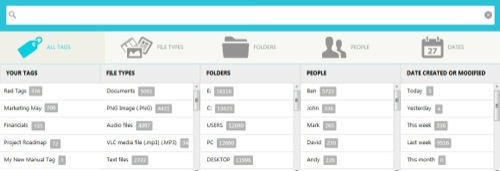What Is Rummage?
Rummage is a Windows application which rethinks how to organise and retrieve files. Instead of having a folder structure, which computers like, Rummage helps you organise your files the way you actually think about them.
By providing a more natural interface for storing and locating your files, Rummage makes it easier and faster to retrieve files when you really need them.
Collecting Data
Rummage collects a variety of information about you and your files. It uses this information to determine how files relate to you and the people, organisations, and projects you work with.
Getting started.
-
Intro Video
The first time you launch Rummage you are presented with the ‘Getting started’ video. This video will give you a quick introduction to Rummage, how to use it and how it can make your life simpler. -
Importing your contacts
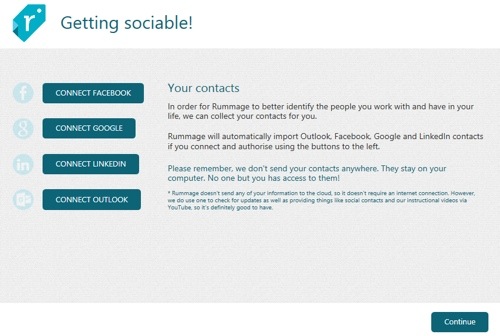
The ‘Getting sociable’ screen allows you to gather contacts from your social accounts.
In order to connect an account, simply click the connect button for the account you want to link, and log into the service. Most services will then ask you to authorise Rummage to download a list of your contacts. -
Finding your documents (Indexing)
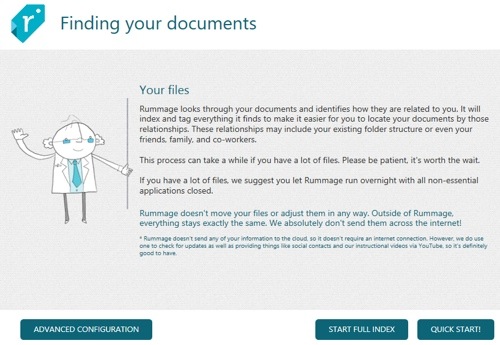
To help you organise and find your documents, Rummage needs to learn about you and your files. This phase is the ‘Indexing’ phase where Rummage creates tags and automatically associates them with the relevant files.
You have three options to choose:
QUICK START!
Choose this option if you just want to quickly try out the Rummage application. It will only index a small proportion of your files to give you a flavour of Rummage.
START FULL INDEX
This is the recommended option, as it will provide the most complete Rummage experience.
However, if you have a lot of files to index this can take a while. We suggest you run the index overnight and close other unnecessary applications.
ADVANCED CONFIGURATION
This option allows you to specify which files and folders you want to index. We suggest you only use this option if you are confident you know exactly which folders you want to index and which you don't.
Social networks.

Getting sociable is easy! You can gather contacts from a variety of social sources, as well as your Outlook e-mail. All you need to do is select the network you want to gather from, and click the appropriate "CONNECT" button.
Once you click "CONNECT" for a social network, you'll be presented with a window displaying that network's application login prompt. We don't have any way of seeing what you enter into these windows, they're direct from the network themselves.
After logging in, most networks present you with a list of permissions Rummage would like to have. We're just asking to be able to gather information about you and your contacts. None of this information is sent off to us, it's just downloaded to your computer so Rummage can make use of it.
When an account is signed in an authorised, the "CONNECT" button will become disabled, and the icon for that network will become highlighted. This means Rummage has all it needs to gather contacts from that service.
You may connect as many services as you like. Once you're finished, you can click "Continue."
Locating Your Files
Rummage uses a drill down method to locate files. This is very flexible because it works with the information you have available in whatever order you think of it. Even if you don't remember all the details, Rummage is able to help guide you to the file you need.
Using tags to find files.

Tags are just special words used to organise files. You can think of them a bit like traditional folders, but tags aren't limited to a particular arrangement.
To make it easier to identify properties of a file, tags are split into categories. These categories help you to find the sorts of information you know about your file.
The search bar, allows you to type text to filter the tags. This makes it really fast to find what you're looking for. You can simply type the first few characters of a name of a person, place, project, or anything else to filter and find the tags you want.
Once you select a tag, the tag is added to the search bar. This gives you the ability to drill down to a unique set of tags related to a file or a group of files.
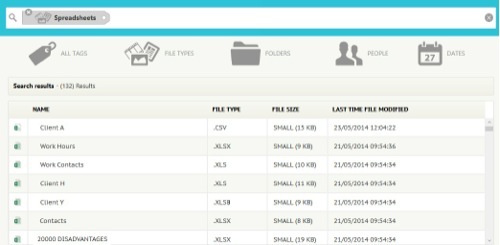
A file may have any number of tags associated with it to help you more easily retrieve it at a later date. The more unique the tags are, the easier it is to locate a particular document. However, the real power of tags comes in the combination of them in a search.
Files related to people.
People are important to us. We relate most things we do to the people involved. So, people are important to Rummage. When setting up Rummage, we have a special section related to importing contacts from Outlook and social networks. This provides Rummage with an awareness of the people you associate with.
While indexing your files Rummage makes special notes when it finds the names of your contacts in files. This allows you to easily locate those files by selecting the person you're looking for.

Combined with other tags, this makes it really simple to find what you're looking for. For example, as above, we're looking for contracts involving John Smith. We select both tags, and we're presented with all contract documents related to John Smith!
Another really great feature is the ability to search by a part of the name. For example, maybe you know a file was related to someone named Mr. Smith. You know you heard their first name, but can't remember it. If you select the Smith tag, Rummage will reduce the name tags down to only Smiths.
Files in Explorer folders.
In Windows Explorer your files are located inside folders. Folders are a convenient method of organising files in a way that is easy for the computer to understand. Unfortunately, being easy for a computer to understand doesn't always mean it's the best order for a human to locate things.
Rummage brings in your existing Windows folders as tags, adding to the power of Rummage without taking anything away from the hard work you've already done to keep things organised.
You may organise your Invoice and Receipt files under My Documents. In order to keep things organised, you've created a structure based on the year, and type. For example, “2012\Invoices”, “2013\Invoices”, “2012\Receipts”. This is very well organised, and it's pretty easy to find invoices for a particular year. But what if you wanted to find ALL invoices?

Because Rummage has brought in your folders and turned them into tags, you can easily look for all invoices from 2012 just like in Windows. With tags, you can also now look up all invoices from any year! (You could equally look for any file type for a particular year.)

Files by dates.
One of the most common ways we, as humans, remember things we actually have in common with computers. Dates are important to us although not always in computer terms. Most of the time we know we received or last worked on a file in a particular month, or sometime last week, or maybe a couple years ago. We don't always remember an exact date like computers do.
Rummage makes it easy to identify approximate dates as well as exact dates and specific ranges of dates.

As always, Rummage can combine dates with other tags, providing great power to drill down to exactly what you're looking for in an efficient manner.
Searching for contents.
While there's great power in searching by tags, sometimes we really want to just look for a word or phrase inside of files. Rummage provides this ability, and allows you to mix and match between these free-text searches and tag based drill down.
To perform a free-text search, simply type the term or phrase in the search bar, and press the enter key. You'll see the new search term added just like tags would be.

Organising Your Files
Keeping your files organised is easy. You can always add new tags, which will help you locate related documents quickly. This makes it simple to highlight new projects, clients, or contacts.
Add an existing tag to a file.
Rummage tries to identify relations to files by searching their contents and other techniques. The methods it uses to associate files to tags is ever evolving and continually improving. Unfortunately, it can't always determine every file associated with a tag.
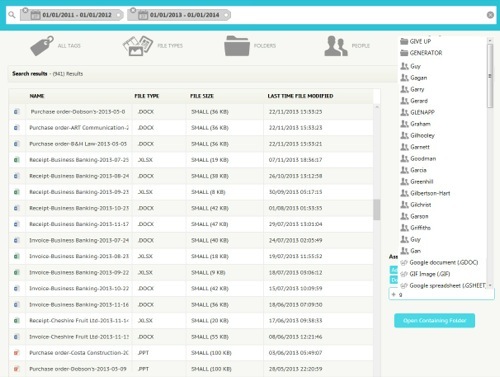
To make up for this, Rummage makes it easy to apply existing tags to files. It's as simple as selecting the file in question, and typing into the new tag box, then pressing enter, or clicking to select a tag.
Creating new tags.
Rummage does its best to identify what tags are going to be relevant to you. As with any automated system, though, it can't know you as well as you do. It's very possible Rummage will miss an important project name, or a company you work with on a regular basis.
So, Rummage allows you to add new tags, which will retrospectively search your files for references to the new tag. This means you can easily update how Rummage organises your files.
Creating a new tag is pretty much just like applying an existing tag to a file. Select a file we want to apply a new tag to, type a new tag name into the new tag box, and press enter.
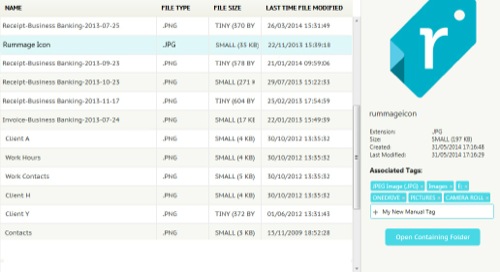
Once a new tag is added to the system, it will show up under the "YOUR TAGS" category in the search assistant. These tags will work just like tags in any other category, but you know they're special to you.
